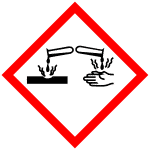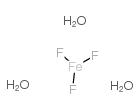三水合氟化铁(III), 99%,Iron(III) fluoride trihydrate
产品编号:西域试剂-WR363577| CAS NO:15469-38-2| MDL NO:MFCD00149718| 分子式:F3Fe·3H2O| 分子量:166.89
本网站销售的所有产品仅用于工业应用或者科学研究等非医疗目的,不可用于人类或动物的临床诊断或者治疗,非药用,非食用,
| 英文名称 | Iron(III) fluoride trihydrate |
|---|---|
| CAS编号 | 15469-38-2 |
| 产品熔点 | 1000 °C |
| 精确质量 | 166.96200 |
| PSA | 27.69000 |
| LogP | 1.06520 |
| 稳定性 | 常温常压下稳定 避免的物料:碱 。加热至100℃时即变为三水合物。微溶于水,不溶于乙醇。与碱金属氟化物作用,可生成诸如K3[FeF6]的氟铁酸盐。溶于热水。用作有机反应的催化剂及用于陶瓷工业。 |
| 储存条件 | 常温密闭避光,通风干燥 |
相关文档
化学品安全说明书(MSDS)
下载MSDS质检证书(COA)
相关产品
| 符号 |


GHS05, GHS07 |
|---|---|
| 信号词 | Danger |
| 危害声明 | H302 + H312 + H332-H314 |
| 警示性声明 | P260-P280-P301 + P312 + P330-P303 + P361 + P353-P304 + P340 + P310-P305 + P351 + P338 |
| 个人防护装备 | Eyeshields;Faceshields;full-face particle respirator type N100 (US);Gloves;respirator cartridge type N100 (US);type P1 (EN143) respirator filter;type P3 (EN 143) respirator cartridges |
| 危害码 (欧洲) | C:Corrosive; |
| 风险声明 (欧洲) | R20/21/22 |
| 安全声明 (欧洲) | S26-S27-S28-S36/37/39-S45 |
| 危险品运输编码 | UN 3260 8/PG 2 |
| WGK德国 | 3 |
| RTECS号 | NO6865000 |
| 包装等级 | III |
| 危险类别 | 6.1 |
|
Section 1: Product Identification Chemical Name:Iron (III) fluoride trihydrate, 98% CAS Registry Number:15469-38-2 Formula:FeF3.3H2O EINECS Number:232-002-4 Chemical Family:metal halide Synonym:Ferric fluoride hydrate
Section 2: Composition and Information on Ingredients IngredientCAS NumberPercentACGIH (TWA)OSHA (PEL) Title Compound15469-38-2100%1mg/m3 (as Fe )no data Section 3: Hazards Identification Material hydrolyzes in contact with moisture releasing toxic and corrosive hydrofluoric acid. Causes delayed, Emergency Overview: deep, slow healing, painful burns. Soluble iron is a poison by ingestion. Primary Routes of Exposure:Ingestion, inhalation, skin, eyes Eye Contact:Causes serious eye damage. Effects may not immediately appear. Skin Contact:Prolonged contact with skin causes delayed deep slow healing painful burns. Inhalation:Dust or hydrofluoric acid fumes will cause chemical burns to the respiratory tract. May cause vomiting, and painful abdominal burns. Soluble iron salts may cause poisoning, liver damage and Ingestion: coma. Fluoride poisoning may cause , weakness, coma, and respiratory paralysis, eye and skin burns and pulmonary Acute Health Affects: edema. iron poisoning causes pink urine, liver damage, coma and death. Prolonged exposure to soluble fluorine compounds can cause deterioration of bone and tooth structure, and Chronic Health Affects: kidney damage. Iron may damage the liver and pancreas and cause pulmonary fibrosis. NTP:No IARC:No OSHA:No SECTION 4: First Aid Measures Immediately flush the eyes with copious amounts of water for at least 10-15 minutes. A victim may need Eye Exposure: assistance in keeping their eye lids open. Get immediate medical attention. Wash the affected area with water. Remove contaminated clothes if necessary. Apply calcium gluconate jelly Skin Exposure: or water soluble calcium salts as antidote. Seek medical assistance. Remove the victim to fresh air. Closely monitor the victim for signs of respiratory problems, such as difficulty Inhalation: in breathing, coughing, wheezing, or pain. In such cases seek immediate medical assistance. Seek medical attention immediately. Keep the victim calm. Give the victim water (only if conscious). Induce Ingestion: vomiting only if directed by medical personnel. SECTION 5: Fire Fighting Measures Flash Point:not applicable Autoignition Temperature:none Explosion Limits:none Extinguishing Medium:none required If involved in a fire, fire fighters should be equipped with a NIOSH approved positive pressure self-contained Special Fire Fighting Procedures: breathing apparatus and full protective clothing. Hazardous Combustion andIf involved in a fire this material may emit corrosive hydrogen fluoride fumes. Decomposion Products: Unusual Fire or Explosion Hazards: No unusual fire or explosion hazards. SECTION 6: Accidental Release Measures To avoid raising dust, small spills can be mixed with powdered sodium bicarbonate, lime, or calcium carbonate Spill and Leak Procedures: and swept up. SECTION 7: Handling and Storage Store material in a tightly sealed bottle away from moisture. If possible, handle material in an efficient fume Handling and Storage: hood. Prolonged exposure to the atmosphere may lead to degradation of the product. SECTION 8: Exposure Controls and Personal Protection Eye Protection:Always wear approved safety glasses when handling a chemical substance in the laboratory. Skin Protection:Wear protective clothing and gloves. Consult with glove manufacturer to determine the proper type of glove. Ventilation:If possible, handle the material in an efficient fume hood. If in form of fine dust and ventilation is not available a respirator should be worn. The use of respirators Respirator: requires a Respirator Protection Program to be in compliance with 29 CFR 1910.134. Ventilation:If possible, handle the material in an efficient fume hood. Additional Protection:No additional protection required. SECTION 9: Physical and Chemical Properties Color and Form:light yellow pwdr. Molecular Weight:112.84 (166.89) Melting Point:no data Boiling Point:no data Vapor Pressure:no data Specific Gravity:no data Odor:none Solubility in Water:slightly soluble SECTION 10: Stability and Reactivity Stability:air and moisture stable Hazardous Polymerization:no hazardous polymerization Conditions to Avoid:contact with moisture Incompatibility:Mineral acids and active metals Decomposition Products:with moisture: hydrofluoric acid SECTION 11: Toxicological Information RTECS Data:No information available in the RTECS files. Carcinogenic Effects:no data Mutagenic Effects:no data Tetratogenic Effects:no data SECTION 12: Ecological Information Ecological Information:No information available SECTION 13: Disposal Considerations Disposal:Dispose of according to local, state and federal regulations. SECTION 14: Transportation Shipping Name (CFR):Corrosive solids, N.O.S. Hazard Class (CFR):8 Additional Hazard Class (CFR):NA Packaging Group (CFR):III UN ID Number (CFR):UN# 1759 Shipping Name (IATA):Corrosive solid, N.O.S. Hazard Class (IATA):8 Additional Hazard Class (IATA):NA Packaging Group (IATA):III UN ID Number (IATA):UN# 1759 SECTION 15: Regulatory Information TSCA:Not listed in the TSCA inventory. SARA (Title 313):Title compound not reportable under SARA 313. Second Ingredient:none SECTION 16 - ADDITIONAL INFORMATION N/A |









 浙公网安备 33010802013016号
浙公网安备 33010802013016号